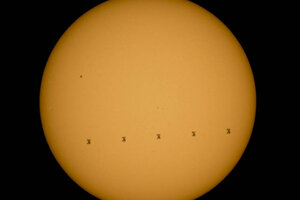Meet the man behind this stunning shot of the space station and the sun
NASA senior contract photographer Bill Ingalls adds another spectacular space history photo to his decades-old collection.

This composite image made from five frames shows the International Space Station, with a crew of nine onboard, in silhouette as it transits the sun at roughly 5 miles per second, Sunday, Sept. 6, 2015, Shenandoah National Park, Front Royal, Va.
NASA/Bill Ingalls/File
At first glance, the image appears to show five ants crawling across a giant orange ball.
In reality, the photo is a composite of five frames, taken on Sunday, of the International Space Station as it traveled before the sun at roughly 5 miles per second. A striking picture that quickly went viral, the image evokes humanity’s minuteness in the vast expanse of space – and showcases the colossal talent of the man who for decades has been capturing space history from Earth.
Meet Bill Ingalls, professional shutterbug and senior contract photographer at NASA headquarters since 1989. “In his post, Ingalls has roamed the nation’s Capitol and White House, and photographed launches from the swamps of Florida to the desolate desert of Kazakhstan,” former NASA writer Edward Goldstein wrote for the space agency’s 50th anniversary commemorative magazine.
The pictures in Mr. Ingalls’ portfolio range from the stunning to the historically significant. Capturing them has involved everything from climbing active volcanoes to snapping pictures of presidents. One of his most iconic shots was a 1998 image of President Clinton showing John F. Kennedy Jr. and his wife Carolyn Bessette-Kennedy a portrait of JFK during a White House showing of Tom Hank’s HBO film series, “From Earth to the Moon.”
“There’s a responsibility that you are the eyes for everyone who can’t be there,” Ingalls told Ask Magazine in 2011. “So there may be times I think an image could be made that’s particularly artistic, but maybe does not help tell the story, so I might have to wave off on that to help tell the story. The goal, of course, is to help tell the story in a creative and interesting way, but not so off the wall that the story somehow gets lost.”
Here’s a look at some of Ingalls’ most recent and remarkable shots:

